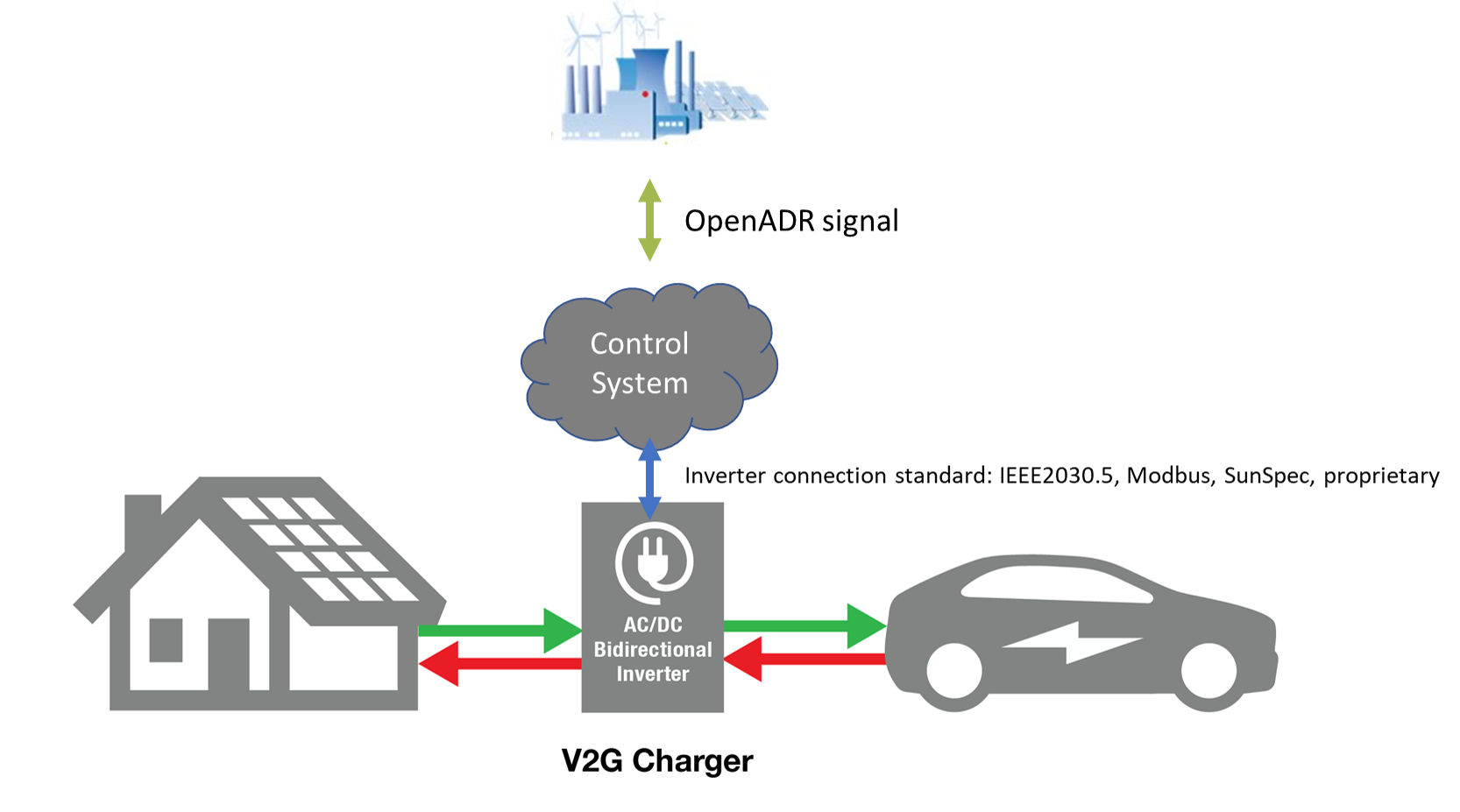|
Purpose of Vehicle-to-Grid (V2G) Integration - and how it relates to OpenADR(see also OpenADR Case Study Sunpower Final.pdf) V2G is an often discussed topic but we have come to realize that the purpose of V2G is often misunderstood or rather overshadowed by electrical connectivity issues. Therefore we wanted to try to clarify this on here. We all know that today's Grid has many challenges. Increasing amounts of variable renewables, ramping up electrification efforts, new electrical consumers like heat pumps, car chargers, etc., as well as climate change, wars, and other factors threaten the balance of production and consumption and therewith the stability of our power supply. Aside from energy efficiency and already existing flexibility (like Demand Response (DR)), Storage is one of the most effective support system for balancing the grid, simply because in most cases it can be turned on and off very quickly and strategically. This is particularly true for battery storage. However, batteries are still expensive and rather bulky and therefore utility scale storage occupies large spaces and represent significant investments. Smaller residential systems are starting to become more affordable but are generally limited to short term supply at reduced capacity. This is where V2G comes into the picture. One of the most important and probably the most expensive component in electric vehicles is the battery. Modern EVs have easily ranges of 300+ miles and the needed battery is consequently of high capacity and high current. These batteries can easily power a home for several days and can provide a high current short term to support the Grid if managed correctly. Therefore these car batteries are excellent Demand Response and Flexibility resources. Utilities, regulators, and businesses have recognized this and have put V2G on their roadmaps. Management of DERs, Batteries, and V2GDemand Side Management (DSM) programs (aka DR, DER, or Flexibility) make use of available capacity in homes, companies, car fleets, and other systems. This capacity can be provided by reducing the power consumption (curtailment in classic DR programs) like changing air conditioning and heating settings, stopping appliances and other systems, etc. However, capacity can also be made available using managed renewables in connection with batteries, up and down regulation of battery chargers (EV), and controlled discharging of batteries, both in fixed or vehicle systems. In particular vehicle fleets represent a significant capacity for short term usage. The OpenADR standard has supported this type management since over a decade with a multitude of installations worldwide. OpenADR messages in most cases provide objectives to customer owned system to trigger a response. These messages can contain variable prices or more specific energy requests. Any and all available capacity can be managed easily and without disturbing the grid controls in this way. Side Effects of V2G - or rather of all grid connected invertersThe electrical grid operates as a highly stabilized system to maintain voltage, frequency, Volt-VAR and other quality aspects of the supply side. The output provided by DC to AC inverters in grid-tie systems is synchronized with the grid itself. However, the quality of the output is often not as good as that of the utility provided electricity and parameters like Volt-VAR etc. need to be adjusted to maintain a balanced grid. These parameters are generally embedded into the operating system of an inverter and used to be adjusted locally in the firmware and settings. Since many years inverters now include remote management systems using Modbus or similar even more advanced protocols.In many cases these parameters - or grid settings - are adjusted once in a while via software updates to the inverter (if internet connection is available). In older systems they will likely never be changed. As the number of grid-connected inverters is increasing, there are concerns that the variation in power quality and settings will disturb the synchronization of the power grid. It is therefore envisioned, or even required in some instances, that inverters offer remote access to make adjustments more frequently. These adjustments to the grid code may become more important as larger percentages of the energy supply are being made available through inverters. This can be a barrier to the introduction of more renewables and even V2G. Utilities will have to decide what the size threshold is to require full control. Ownership and control questions will also play a role as customers do not generally like to be directly influenced by utility signals. Furthermore, controlling a huge number of small, privately owned inverters - including V2G - may not be in the best interest of the utilities either. OpenADR can work around the perceived "do not control me" issue by using its typical "inform and motivate" approach from the utility to a customer owned or managed control system. General adjustment requests can be sent to the interface point and then executed via any available control standard like IEEE 2030.5. Modbus, Sunspec, etc. and in accordance to other specifications like IEEE 1547, SAE J3072, California Rule 21 and others.
In short...EV batteries can function as grid resources in a way similar to solar/storage DER. For example, Sunpower’s Virtual Power Plant implementation utilizes all four OpenADR services:
|


